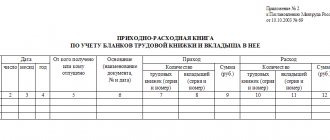Reflection in 1C of the sale of goods and services (work) has a number of nuances. How you show it in the program determines how correctly your income will be reflected in your reporting.
In this article, using examples, we will look at step-by-step instructions for selling services and goods in 1C 8.3. You will learn:
- what document to formalize the sale of goods and services in 1C;
- what kind of postings should be made in 1C 8.3;
- How to issue an invoice to the buyer.
For more details, see the online course: “Accounting and tax accounting in 1C: Accounting 8th ed. 3 from A to Z"
Attention! The VAT rate has been changed from 01/01/2019 from 18% to 20% and from 18/118 to 20/120.
Sales of goods, works, services
Work on selling products in an organization begins with concluding an agreement with the buyer; the agreement can sometimes be an invoice for payment. Once the intent to purchase has been secured by contract, the buyer is usually issued an invoice. The invoice indicates the seller’s details, including bank details, the amount of payment, taxes (VAT, excise taxes) included in the cost of goods (work, services).
The invoice is issued by an authorized person, usually a manager or accountant, in 2 copies: one for the buyer, the second for the accounting department. Signed by the manager and chief accountant. Own copies are filed in chronological order, copies of the buyer are sent to him.
Settlements with buyers and customers are carried out on account 62 “Settlements with buyers and customers”. Revenue is reflected in subaccount 90.1 “Revenue”.
Tasks
Let's look at a few more examples of tax calculations.
1. in the amount of 118,000 including VAT.
- DT 08 (19) KT 60 - materials were received (100,000) and the supplier’s invoice was taken into account (18,000);
- DT TS (technical account for mutual settlements with counterparties) KT 68 - VAT restored (18,000);
- DT 68 CT 19 - tax accepted for deduction (18,000).
2. Reflection of an advance issued without accepting the right to deduct VAT.
From the buyer's side:
- DT 60 CT 51 - advance paid (118,000);
- DT 19 KT TS - accepted for VAT accounting (18,000).
From the seller's side:
- DT 08 (19) CT 60 - equipment received (100,000) and seller’s account accepted (18,000);
- DT TS CT 19 - the tax amount was restored (18,000);
- DT 68 CT 19 - tax accepted for deduction (18,000).
Another option for processing the operation.
From the seller:
- DT 51 CT 62 - prepayment received - 118,000;
- DT TS KT 68 - tax charged - 18,000.
From the buyer:
- DT 62 CT 90 - sales of products (if 62 is used as a technical account, an entry is created in the amount of one hundred thousand rubles) - 118,000.
- DT 90 CT 68 - the amount of tax on products sold is reflected (the posting is not created if account 62 appears) - 18,000;
- DT 68 CT TS - the tax amount has been restored (the posting is not created if account 62 appears) - 18,000.
Goods, finished products
To ship goods and products, a consignment note TORG-12 and transferred to the warehouse to the warehouseman. releases goods based on a power of attorney
If the organization has shipped products or goods and ownership has passed to the buyer, then the fact of sale is reflected in the accounting records with the following entry:
Debit 62 Credit 90.1 - revenue from the sale of products (goods) is reflected. Revenue is reflected together with VAT.
At the same time, it is necessary to reflect the write-off of the cost of goods (products) in the debit of subaccount 90-2 “Cost of sales”, income from the sale of which is recorded in subaccount 90.1.
Debit 90.2 Credit 41 (43,45,20...) - the cost of goods sold is written off.
The organization must charge VAT simultaneously with the sale. She must issue an invoice within five calendar days from the date of shipment of the goods.
Debit 90.3 Credit 68 “Calculations for VAT” - VAT has been charged.
Postings for the sale of goods in wholesale trade
Payment for goods can usually be made by prepayment or upon shipment of the goods.
By prepayment
Example:
The organization, after receiving an advance payment from the buyer, shipped goods in the amount of 99,500 rubles. (VAT RUB 15,178).
Postings:
| Account Dt | Kt account | Wiring Description | Transaction amount | A document base |
| 62.02 | Received money for the goods from the buyer | 99 500 | Bank statement | |
| 76.AB | 68.02 | Issuing an invoice for advance payment | 15 178 | Ref. invoice |
| 62.01 | 90.01.1 | Revenue from the sale of finished products or goods is taken into account | 99 500 | Packing list |
| 90.03 | 68.02 | VAT is charged on sales | 15 178 | Packing list |
| 90.02.1 | 41.01 | Sold goods written off | 64 000 | Packing list |
| 62.02 | 62.01 | Advance credited | 99 500 | Packing list |
| An invoice for sales has been issued | 99 500 | Invoice | ||
| 68.02 | 76.AB | Deduction of advance VAT | 15178 | Invoice |
By shipment
Example:
The organization shipped goods worth RUB 32,000 to the buyer. (VAT 4881 rub.). Payment was received after delivery.
Postings:
| Account Dt | Kt account | Wiring Description | Transaction amount | A document base |
| 62.01 | 90.01.1 | Revenue from sales of goods is reflected | 32 000 | Packing list |
| 90.03 | 68.02 | VAT is charged on sales | 4881 | Packing list |
| 90.02.1 | 41.01 | Sold goods written off | 385 | Packing list |
| An invoice for sales has been issued | 32 000 | Invoice | ||
| 62.01 | Payment received from buyer | 32 000 | Bank statement |
Agreement with a special transfer of ownership
If the contract specifies that ownership of the goods will be transferred not after shipment, as is considered by default, but, for example, after payment, such an agreement is considered an agreement with a special transfer of ownership. Shipped goods must be accounted for on account 45 “Goods shipped”.
Debit 45 Credit 41 - goods (GP) were shipped under an agreement with a special transfer of ownership.
Even though title has not passed to the buyer, VAT must be charged on the day of shipment.
Debit 76 “Calculations for VAT on advances received” Credit 68 - VAT accrued on goods shipped.
Debit 51 Credit 62 - the buyer’s payment is reflected.
Debit 62 Credit 90.1 - revenue is reflected.
Debit 60.2 Credit 45 - the cost of shipped goods is written off.
Debit 90.3 Credit 68 - VAT charged
Debit 68 Credit 76 “Calculations for VAT on advances received” - VAT accrued on shipments has been restored.
Tax accounting for the buyer
The client who has made an advance payment on account of supplies is subject to deduction of the tax amounts presented by the seller on the basis of the following documents:
- accounts;
- payment slips confirming the transfer of funds;
- agreement.
Let's take a closer look at them. The Ministry of Finance does not provide a special form of invoices used for prepayments. Therefore, a standard document template can be used. If the contract contains a condition on the transfer of money without specifying the exact amount, then the tax calculated on the basis of the figures indicated in the invoice issued by the seller is subject to deduction. If such a clause is missing altogether, then the tax cannot be compensated.
Services, works
If an organization has provided services or performed work, then this fact is documented in an act in a free form; there is no standard form, for example, an act of provision of services or an act of completed work. You also need to issue an invoice .
Postings for the provision of services and performance of work are the same as for the sale of goods and finished products:
Debit 62 Credit 90.1 - revenue accrued for services rendered.
Debit 90.2 Credit 20, 26 - the cost of services provided and work performed is written off.
Debit 90.3 Credit 68 - VAT charged.
Creating and filling out a document for the sale of services and goods in 1C
We go to the “Sales” Menu, then follow the link “Sale of goods and services” to the list of documents. Click the “Sale” button and select “Goods, services, commission” from the drop-down list:
A new 1C Accounting document window will open. Let's start filling it out:
Required fields are usually underlined with a red dotted line. It is not difficult to guess that first of all you need to indicate:
- Organization
- Counterparty
- Stock
- Price type
The price type specifies the price at which the product will be sold. If the price type is specified in the counterparty agreement, it will be set automatically (from the previously established values in the Item Price Settings documents). If the price type is not specified and the person responsible for filling out the document has rights to edit sales prices, the price is specified manually when creating the tabular section.
I note that if the 1C 8.3 program keeps records of only one organization, the “Organization” field does not need to be filled in, it simply will not be visible. The same applies to the warehouse.
We have indicated the necessary details in the header of the document; let’s move on to filling out the tabular part.
You can use the “Add” button and fill out the document line by line. But in this case, we will not see the remaining goods in the warehouse. To make it easier to select products in the table section, click the “Selection” button:
The “Item Selection” window will open, where we see the remaining product and can safely select it. When you select a particular line, the program will ask for the quantity and price (if the price type is not selected) of the selected product.
The items selected and ready to be transferred to the document are reflected in the lower part of the window. After all the necessary positions are selected, click “Move to document”.
Now let's add a service to the document. Services are selected on the “Services” tab. Let’s go into it and also click the “Selection” button. I selected the “Delivery” item, indicated the quantity, cost and transferred it to the document.
To provide one service to multiple contractors, it is convenient to draw up one document - Provision of services. This can be especially useful for enterprises that provide periodic “subscription services”: for example, in the housing and communal services sector.
Here's what I got:
Now the document can be posted. When carried out, transactions will be generated that will reflect the fact of sale of goods in accounting.
The concept of financial result
Financial result is understood as an indicator that characterizes the results of an enterprise’s activities, namely whether a profit is made or a loss is incurred. The period for determining the financial result is a calendar month.
The value of the financial result is influenced by such indicators as the amount of sales of products (goods, services, works), income from non-sales transactions, as well as expenses incurred in connection with the manufacture, acquisition and sale of products.
The financial result is defined as the difference between the profit from products sold (goods, services, work) and the costs of its production (purchase). Also, the financial result indicator is revealed minus taxes and fees that are payable to the budget, as well as costs associated with sales (delivery of goods to the retail network, salaries to sellers, storage costs, etc.).
What primary documents accompany the provision of services?
Goods and works are sold in material form, their transfer from the seller to the buyer is carried out physically and only at the time of acceptance and transfer. It is the fact that the moment of provision of a service is also the moment of its consumption that gives rise to the specifics of registration of its delivery and acceptance and the procedure for reflection in tax accounting. After all, it would seem unrealistic to hand over a service according to an act every time it is rendered, but to formalize the delivery by an act after it has been rendered - is this correct?
The table lists the main types of services and possible options for processing their delivery and acceptance from the perspective of regulatory authorities:
| Type of service | Supporting documents | Base |
| Utilities | Can be confirmed:
| Letter 07/29/2010 No. 03-03-06/1/494. |
| If the requirements of the law and (or) the terms of the contract do not require the parties to prepare monthly acts, then they may not be drawn up. | Letter from the Federal Tax Service for Moscow dated June 11, 2010 No. 16-15/ [email protected] | |
| Communication (telephone, Internet) | An order from the manager with an approved list of employees who are provided with cellular communications for production needs, indicating the consumption limit. | Letters:
|
| Agreement with the operator. | ||
| Detailed telecom operator bills. | ||
| If the requirements of the law and (or) the terms of the contract do not require the parties to prepare monthly acts, then they may not be drawn up monthly (clause 1 of Article 252, clause 25 of clause 1 of Article 264 of the Tax Code of the Russian Federation). | ||
| Lease (sublease) of real estate, vehicles | A completed lease (sublease) agreement. Documents confirming payment of rental payments. Certificate of acceptance and transfer of leased property. Monthly registration of acts is not required (clause 1 of Article 252, clause 10 of clause 1 of Article 264 of the Tax Code of the Russian Federation). | Letters:
|
Let's summarize.
The act must be drawn up in two cases:
- services are of a production nature and are taken into account as part of material costs (paragraph 3, paragraph 2, article 272 of the Tax Code of the Russian Federation);
- Legislation and/or the terms of the contract provide for the drawing up of an act (clause 1 of Article 252, Article 254, 264, 265 of the Tax Code of the Russian Federation).
There is no need to draw up an act:
- in cases not listed above;
- the contractor’s income and the customer’s expenses can be confirmed by a report (legal or consulting), invoice details (providing communications), an agreement and an act of acceptance and transfer of property for rent.
Exceptions
The legislation provides for cases when accrual from advances received is not provided:
- for goods that were sold outside of Russia;
- for work taxed at a rate of 0%;
- for services for which tax is not charged at all;
- if the company does not pay VAT at all;
- if the duration of the production cycle exceeds six months (the list of such goods is approved by Resolution No. 468).
In order not to charge tax on prepayments for work with a long production cycle, you must submit, along with the tax return, a copy of the contract with the buyer, a document confirming the features of the technological process.
An enterprise can take advantage of the benefit if the accountant keeps separate records of operations with a long production cycle and VAT amounts on materials involved in this process. These requirements are established by the Tax Code of the Russian Federation.
If these conditions are not met, tax on the advance payment is calculated on a general basis. There is no deferment available. If the seller charged VAT in one quarter and provided documents for the benefit in another, he cannot reduce the tax base, change the invoice or submit a “clarification”. The procedure for maintaining complex accounting is not prescribed by law. Therefore, it is regulated by the internal policies of the organization.
The disadvantage of this scheme is the following: the organization can take into account the amount of VAT on goods purchased for long-term production only on the day the product is sold. If an enterprise received an advance without paying tax, then it will not be possible to reimburse VAT from the budget until the products are sold. Therefore, before using the benefit, you need to evaluate the economic benefit of the operation.







